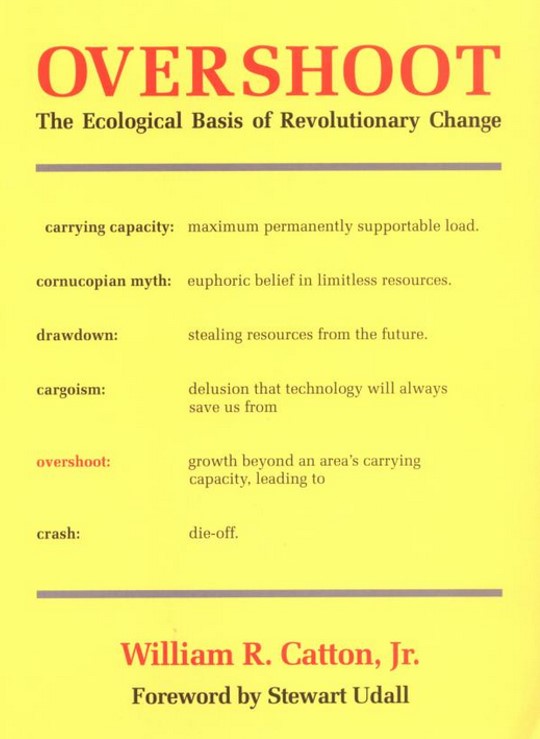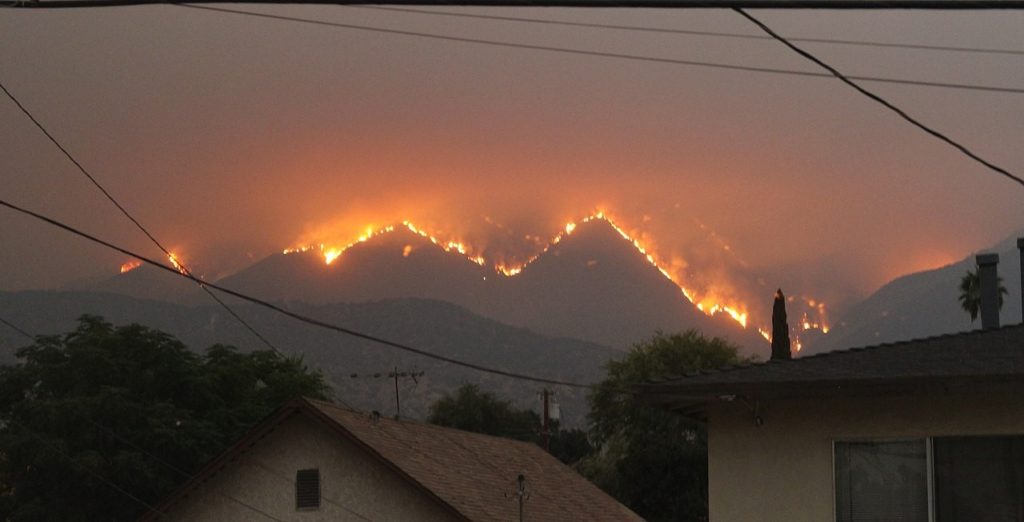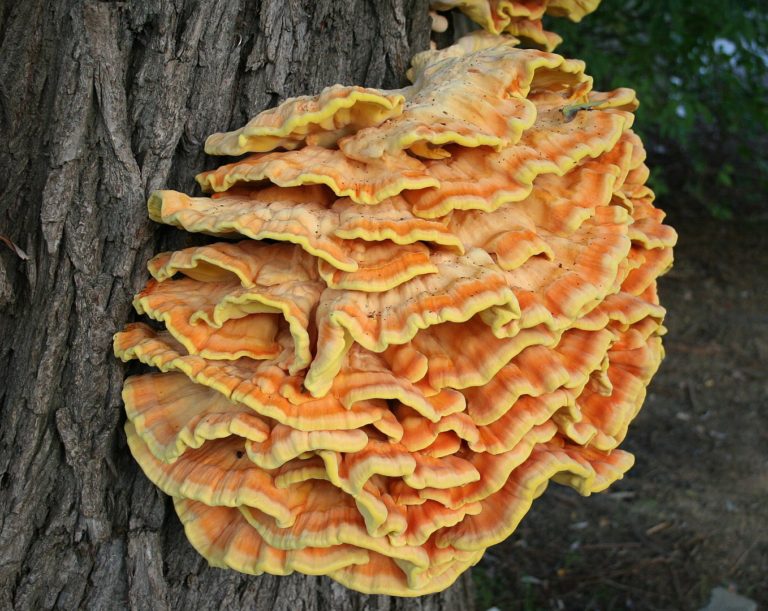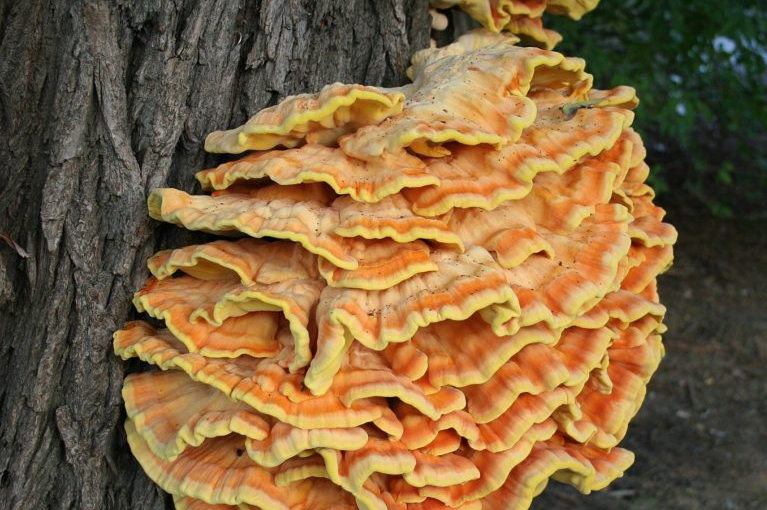This past week, our Gaian Book Club gathered to discuss two books on collapse, How Everything Can Collapse, and Another End of the World is Possible. That’s unremarkable in its own right, considering the depth of literature and the increasing obsession with this topic many people have. Several of the participants even noted just how much they’ve read on the subject—often much to the frustration of less concerned or less interested spouses, parents, and children!

It’s not every cover that provides you with helpful definitions.
But there’s one point that particularly stuck with me from our conversation. Several referenced the seminal work of William Catton’s Overshoot. In it Catton notes the important point that ecological stresses are signs of overshoot (living beyond a system’s carrying capacity). Funnily, at least to me, Catton starts his book with a quotation by Lester Brown (who founded the sustainability think tank I worked with for 16 years). Brown notes:
“Signs of stress on the world’s principal biological systems—forests, fisheries, grasslands, and croplands—indicate that in many places these systems have already reached the breaking point. Expecting these systems to withstand a tripling or quadrupling of population pressures defies ecological reality.”*
Catton’s Overshoot makes it clear that collapse is the breaking down of these systems. And that is what we’re seeing today—unprecedented fires and storms, record ice melt, extinctions, dead zones, as well as the radicalization of governance and reaction to that. These are the “symptoms of collapse,” as Krista Hiser noted during the discussion. In other words, we’ve been in the collapse process for years, and perhaps far longer.**
But Hiser’s words made me realize that the bad things she listed aren’t symptoms of collapse but collapse itself. Like the protest chant: “This is what democracy looks like!” Well, this is what collapse looks like. People turning away from reality (whether via self-delusion or entertainment), electing “clowns” (Joe Biden’s word not mine!) who promise security or to make things great again, all while systems break down around us. Oh and did I mention pandemics?
I’m not sure why this very obvious point didn’t dawn on me until this moment. Perhaps it was a bit of denial. Or perhaps because I had been warning about collapse since 2003, but always as if it was in the future. Or possibly because I read the same news as everyone else, where the stock market has stayed eerily up even as the economy has shrunk dramatically (by a third in the US) as we try to keep COVID-19 under control. Or maybe because there’s so much distracting (even if ultimately irrelevant) news coming from the White House: debate debacle, didn’t pay taxes, frightening Supreme Court nominee, Trump’s got COVID! Not to mention all the disaster news: we’re on Hurricane Delta now. And the fires continue to rage in the west. And when those are out there’ll be more in Australia, South America, and on and on. To the point where we just can’t respond and we just stop paying attention (or it doesn’t even make it into the news because there’s just too much to report). This is collapse.

Bobcat Fire in Los Angeles. Note that I flipped the image, and damn if it doesn’t now look like an overshoot and collapse growth curve! (From Eddiem 360).
And eventually, we’ll turn to worry only about ourselves—hoarding food and toilet paper, clinging to our jobs whether meaningful or useful or not, hoping to insulate ourselves at least to some degree from the threats closing in from all directions. And yes, many of us live in that reality already. That’s the point. This is collapse. In fact, as I was writing this reflection, I found this essay, which says this same thing I’m saying but better (though focused on the US rather than the world). The author lived through the Sri Lankan civil war, inevitably focusing on daily frivolities as others were dying around him. He included some of his photos from a two week period during that time: Playing scrabble one day, photographing a burnt body in front of his office the next, going to a concert, watching smoke rise up from a bomb at a mall. As he observes, trying to sustain a sense of normalcy while things fall apart around you, this is collapse.
Of course, on the one hand that’s revelatory. On the other hand, it’s a completely “duh” moment. This is the realm that Transition Towns and Ecovillages have been inhabiting for years. And Deep Adaptation, now, and yes, Gaianism, too. I am trying to bring people together around our connection to the living planet we depend on and are part of, both to heal the Earth and ourselves, but also to help cultivate communities that can help get us through the difficult transition ahead (and build something good on the other side if we, as a species, make it that far). As came up in the discussion, individualism is a luxury “and not that effective as a survival strategy.” The idea that we can go it alone, supported by money in the bank and deliveries from Amazon is utter nonsense.***
Strategies to Live with Collapse
While it came up only briefly (we covered a lot of ground), there are strategies for living with collapse (not through collapse, not in collapse, but I’d argue, “with” as one lives with a chronic disease). Not to avoid the trauma, but to at least reduce the pain and insecurity it breeds.
Chicken of the Woods in all its glory. From collapse comes new life, at least in this case. (From voir ci-dessous)
First and foremost, to quote John Michael Greer’s wise words: “Collapse now and avoid the rush.” Quite soon, the rush will be here (if it hasn’t reached you already), but acting now still might mean you’re slightly ahead of the curve. So develop skills that may mean the difference between life or death. This week I harvested some Chicken of the Woods and cooked it. It’s delicious and nutritious and very difficult to confuse with anything poisonous. Foraging is fun, nature-connecting, and may help with our navigating the implosion of the global food economy. Learning skills that can keep you thriving—farming, being a doula (for birth or death), wilderness first aid, bicycle repair (or the repair of anything)—all these can be a good way to increase your and your community’s well-being and maintain a sense of control during the collapse.
Even more important, I’d argue, is redeveloping social capital and “mutual aid” networks. This is at the heart of the Gaian philosophy. The hope is to develop local communities of those who understand our utter dependence on the Earth, as well as the moment in time we’re living through—connecting them to Gaia and to each other, and by developing local groups (or guilds), increase their potential to act collectively to slow down Earth’s decline (to whatever degree remains) as well as increase their chances of navigating the collapse as safely and sanely as can be hoped (as well as bring others into the fold through extending that aid to others in the community).****
And third, as a few participants noted, staying present, experiencing “radical joy,” connecting to the birds, trees, and life around us, and to each other, even as tragedy looms around every corner, that’s most important. That’s why meditating each day outdoors, and a group forest meditation every Sunday, are fundamental parts of the Gaian Way for me.
Of course, that’s not to say we shouldn’t also act—to slow down collapse, to create post-collapse cultures that are ecocentric, and so on. But that should come not from a place of ‘we have to act ASAP or else’ but because it’s the right thing to do and a good thing to do with the life energy we have, regardless of the outcome. In fact, at this late stage, that may be the only healthy place from which to approach this. If we keep trying to “save the world,” when it becomes clear we can’t, what happens to all the terrified and disillusioned activists? Do they quit? If instead, from the beginning, they’ve been following Kim Stanley Robinson’s sage advice of orienting on the question of, “How much will we choose to save?”, well then, they can confidently adjust course and find new ways to work toward healing and honoring Gaia, no matter what the future brings.
We’re living with collapse. And it’s scary. But at the same time, knowing that can be freeing. Maybe I really can stop worrying about things out of my control and focus on what I can do, whether that’s inspiring someone to live more sustainably or restoratively, bringing together a group to meditate and and cultivate community, or teaching my son (and myself) karate, cooking, and other life skills that’ll only become more essential as he grows up.
—
*Fun fact: Brown was writing in 1978. Since then the world’s population has grown about 80 percent. If we start with the 1950 baseline (2.5 billion), the world’s population has already tripled and is on track to quadruple by 2050.
**Quick aside: Brown’s quotation comes from The Twenty Ninth Day, another seminal work, the very best part of which is the story that gives the book its title. If a population of organisms is doubling every day and completely fills its environment on the 30th day, when is the environment half full? You might want to guess day 15, but of course, it’s Day 29. Exponential growth is a dangerous thing—one we’ve been doing for years (in both population and economic terms)—and one reason why even if we weren’t already actively in a state of collapse, we couldn’t prevent it anyway—we’ve grown too big and we’ve too completely filled up and consumed our environment. If we’re not on Day 30, we’re certainly approaching dusk of the twenty ninth day.
***Unless, that is, you’re a billionaire. But then you have a different problem: how do you prevent your security staff from taking over the beautiful bunker you built for yourself? (I wish I was joking but that’s a question Douglas Rushkoff has really been asked.)
****And as John Halstead notes in Another End of the World is Possible, mutual aid doesn’t need to stop at humans. Integrating other species makes sense, which we can do through the efforts we pursue, such as restorative agriculture or sustaining local wild lands and the biodiversity there (whether that’s building bat boxes or dealing with the most noxious invasive species). Taking care of those lands and species will improve them (just as Indigenous people have stewarded forest ecologies for thousands of years) while caring for us as well.





